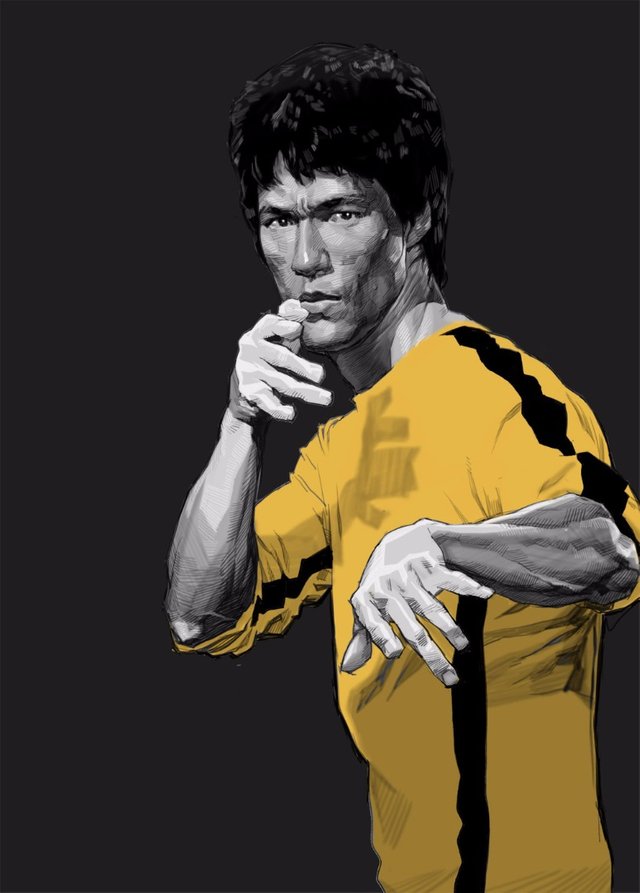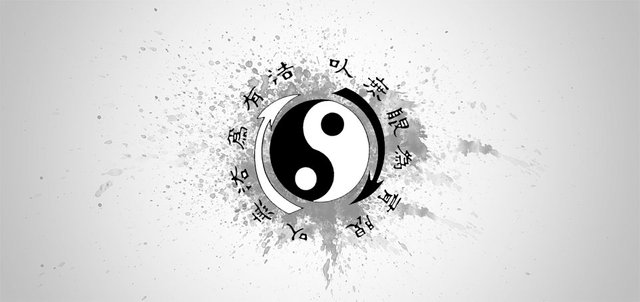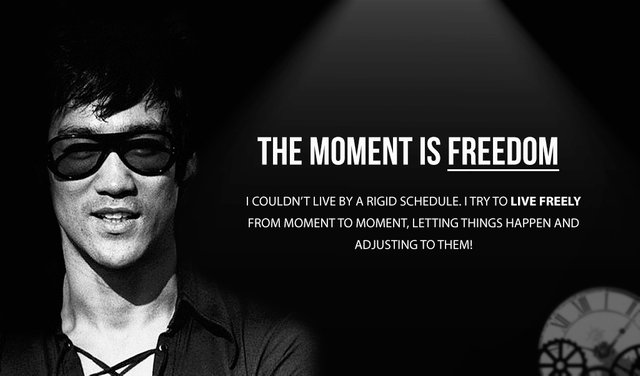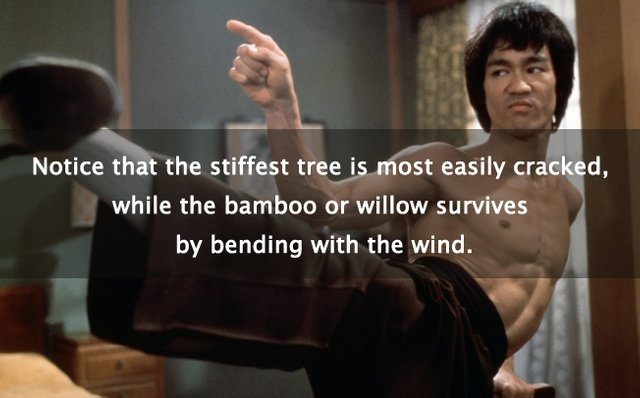Bruce Lee’s philosophy is fundamentally Taoist and Libertarian in nature (part 1)

Art Courtesy: kse332
Bruce Lee has always been my idol since I was 3 or 4 years old, living in a Cambodian refugee camp on the border with Thailand.
I remember that a movie of Bruce Lee was once displayed in one of those typical wooden facilities that were built throughout the camp. This facility had a hole through which I could slide in and enjoy one of Bruce Lee’s movies. I don’t remember which movie it was, but to this day I still remember the excitement of the public and the energy Bruce Lee gave to all of us spectators.
As a young child, I fantasized about his powers: Who was stronger? Bruce Lee, Robocop or Terminator? To compare him with Robocop and Terminator is a sign that I have attributed to him superhuman powers.
In this post, I would like to write about Bruce Lee’s philosophy and its connection with Taoism, which would indirectly make his philosophy contain libertarian elements. If you would like to read more about the connection between Taoism (Yin/Yang philosophy) and Libertarianism, please see this post of mine.
In what way is Bruce Lee’s philosophy Taoist? As my analysis is quite long, I will divide in into 2 or 3 separate posts. In this part, I would like to discuss two of five attributes that I have identified in Bruce Lee’s martial arts philosophy that is fundamentally Taoist:

Jeet Kune Do's symbol. Jeet Kune Do is the martial arts that Bruce Lee had founded. As you can see, it revolves around the Taoist Yin/Yang. The Chinese characters indicate: "Using no way as way" and "Having no limitation as limitation".
1. Be one with the Tao; be formless like water, and be pliable
Bruce Lee believed that the person who is trained within a particular martial arts style and who clings to it indefinitely or a person who is only trained within a particular philosophical doctrine becomes self-delusional. He thought that the person who is incapable of exceeding his style or doctrine is stiff and narrow-minded. His narrow-mindedness makes him blind to observe objectively and to see the truth. He is what Bruce Lee calls, ‘the traditional man’. Bruce Lee wrote:
One can function freely and totally if he is ‘beyond system.’ The man who is really serious, with the urge to find out what truth is, has no style at all. He lives only in what is. (Bruce Lee, 1975, p. 17)
But in classical styles, system becomes more important than the man! The classical man functions with the pattern of a style! (Bruce Lee, 1975, p. 18)
How can there be methods and systems to arrive at something that is living? To that which is static, fixed, dead, there can be a way, a definite path, but not to that which is living. Do not reduce reality to a static thing and then invent methods to reach it. (Bruce Lee, 1975, p. 18)
Classical forms dull your creativity, condition and freeze your sense of freedom. You no longer ‘be,’ but merely ‘do,’ without sensitivity. (Bruce Lee, 1975, p. 19)
You cannot see a street fight in its totality, observing it from the viewpoint of a boxer, a kung-fu man, a karateka, a wrestler, a judo man and so forth. You can see clearly only when style does not interfere. You then see it without ‘like’ or ‘dislike;’ you simply see and what you see is the whole and not the partial. (Bruce Lee, 1975, p. 24)

He thought that committing himself to styles limits both his potential and his self-expression. This critique is however not only limited to martial arts. He extended this critique to Confucianism, a philosophy which he considered as too rigid, and too narrowly focused on set rules and traditions. According to Bruce Lee, man ceases being a human being and instead becomes a mechanical man, a product of mere tradition if he reveres and just follows rules and mannerisms. The philosophy that perfectly fits Bruce Lee’s vision of a self-expressive and ‘style-less’ martial arts is the epistemologically anarchistic Taoism. How can a person, according to Bruce Lee and Taoism, find his true potential and express himself honestly? The answer is to become formless, pliable, and forever adaptable just like the Tao is formless, pliable, and forever in flux.
The Tao Te Ching, the founding book of Taoism written by the Chinese philosopher Lao Tze, states the following beautiful metaphor of life (flexibility and softness) and death (rigidity and hardness):
A man is born gentle and weak.
At his death he is hard and stiff.
Green plants are tender and filled with sap.
At their death they are withered and dry.
Therefore the stiff and unbending is the disciple of death.
The gentle and yielding is the disciple of life.
Thus an army without flexibility never wins a battle.
A tree that is unbending is easily broken.
The hard and strong will fall.
The soft and weak will overcome. (Tao Te Ching, Chapter 76)
Both Lao Tze and Bruce Lee took water as the ultimate metaphor for that which is flexible and soft. Bruce Lee maintains that in order to fulfil your true potential and express yourself honestly you should become like water, formless. To be like water means to be an objective observant, relaxed and to be flowing with life – to be one with the Tao. In the Tao Te Ching one can find the following lines:
Under heaven nothing is more soft and yielding than water.
Yet for attacking the solid and strong, nothing is better;
It has no equal.
The weak can overcome the strong;
The supple can overcome the stiff. (Tao Te Ching, Chapter 78)

There is a story about Bruce Lee’s discovery of what it means to be like water and to be united with the Tao. I am not sure about the authenticity of the story, but I will share it nonetheless as it helps to illustrate the significance of being formless in combat or in life:
Bruce, at the age of seventeen, had been training in gung fu for four years with Sifu Yip Man, yet had reached an impasse. When engaged in sparring Bruce found that his body would become tense, his mind perturbed. Such instability worked against his goal of efficiency in combat.
Sifu Yip Man sensed his trouble, and approached him. ‘Lee,’ he said, ‘relax and calm your mind. Forget about yourself and follow the opponent’s movements. Let your mind, the basic reality, do the counter-movement without any interfering deliberation. Above all, learn the art of detachment.’
Bruce Lee believed he had the answer to his problem. He must relax! Yet there was a paradox: the effort in trying to relax was inconsistent with the effortlessness in relaxing, and Bruce found himself back in the same situation.
Again Sifu Yip Man came to Bruce and said, ‘Lee, preserve yourself by following the natural bends of things and don’t interfere. Remember never to assert yourself: never be in frontal opposition to any problem, but control it by swinging with it.’
Sifu Yip Man told Bruce to go home for a week and think about his words. Bruce spent many hours in meditation and practice, with nothing coming of it. Finally, Bruce decided to go sailing in a junk (boat). Bruce would have a great epiphany. ‘On the sea, I thought of all my past training and got mad at myself and punched the water. Right then at that moment, a thought suddenly struck me. Wasn’t this water the essence of gung fu? I struck it, but it did not suffer hurt. I then tried to grasp a handful of it but it was impossible. This water, the softest substance, could fit into any container. Although it seemed weak, it could penetrate the hardest substance. That was it! I wanted to be like the nature of water.
Therefore in order to control myself I must accept myself by going with, and not against, my nature. I lay on the boat and felt that I had united with Tao; I had become one with nature.[1]
Bruce Lee emphasized the importance of ‘a style of no style’ that he later would regret the name Jeet Kune Do as a name implies limitations or specific parameters. Bruce Lee wanted it to resemble the Tao, nameless and of almost supernatural power.
Chapter one of the Tao Te Ching states:
The Tao that can be told is not the eternal Tao.
The name that can be named is not the eternal name. (Tao Te Ching, Chapter 1)
See this video in which Bruce Lee asserts that we should be like water:
https://www.youtube.com/watch?v=cJMwBwFj5nQ
2. Break rules and conventions and have no way as your way
Jeet Kune Do does not limit itself to styles. It takes from other styles what is useful, discards what is useless, and add what is uniquely our own. The slogan of the Jeet Kune Do logo reads two things: (a) take no way as your way, and (b) take no limitation as your limitation. As styles, rules, conventions, mannerisms limit us we should break them and go beyond them. Jeet Kune Do is therefore iconoclastic. Bruce Lee wrote:
Jeet Kune Do favors formlessness so that it can assume all forms and since Jeet Kune Do has no style, it can fit in with all styles. As a result, Jeet Kune Do utilizes all ways and is bound by none and, likewise, uses any techniques or means which serve its end. (Bruce Lee, 1975, p. 12)
What are the characteristics of a martial arts with no style? According to Bruce Lee, it becomes open-minded, non-traditional, simple, direct, and effective. Bruce Lee contended that: Jeet Kune Do does not beat around the bush. It does not take winding detours. It follows a straight line to the objective. Simplicity is the shortest distance between two points. (Bruce Lee, 1975, p. 12)
In Enter the Dragon, there is a scene in which an ostentatious man asks Bruce Lee what his style is. Bruce Lee answers: “You can call it the art of fighting without fighting”. Being challenged by the man to show this style, Bruce Lee cunningly proposes to take a boat to a nearby island where they can fight. When the man set foot on the boat, Bruce Lee let the boat drift away and pulls it on a line. The essence of the story is that
(a) one should not be pretentious as that is not honest self-expression, and
(b) a fight should be won in the most direct and easiest manner, preferably without the use of violence.[2]
You can find the videoclip here:
https://www.youtube.com/watch?v=o_Ycw0d_Uow
I hope that you have enjoyed the reading. I know that this is already quite a lot of text. I will follow-up with another post in which I identify three other characteristics of Bruce Lee’s philosophy and relate them to Taoism and Libertarianism.
Footnotes
[1] From http://www.becoming.8m.net/bruce02.htm
[2] The scene is actually based on an old Japanese Samurai folk tale. The tale goes as follows:
“While travelling on a ferry, a young samurai began bullying and intimidating some of the other passengers, boasting of his fighting prowess and claiming to be the best in the country with a samurai sword. When the young warrior noticed how unmoved [Tsukahara] Bokuden [a legendary Japanese swordsman] was, he was enraged and not knowing who he was dealing with challenged the old master to a duel. Bokuden told him; ‘My art is different from yours. It consists not so much in defeating others but in not being defeated.’ He continued to inform him that his school was called The Mutekatsu Ryu meaning ‘to defeat an enemy without hands’. The young samurai saw this as cowardice and demanded satisfaction so he told the boats-man to stop at an island so they could do battle there. However when he jumped into the shallow waters to make his way to the fight venue, Bokuden got hold of the boats-man’s pole and proceeded back to deeper waters minus a now irate young samurai. The wise old master laughed and shouted to his would be adversary; ‘Here is my no sword school!’” (See, http://www.historyoffighting.com/tsukahara-bokuden.php)
Bibliography
History Of Fighting. Retrieved fromhttp://www.historyoffighting.com/tsukahara-bokuden.php
Lao Tze. Tao Te Ching. Retrieved fromhttp://www.schrades.com/tao/taotext.cfm?TaoID=1
Lee, B. (1975). Tao Of Jeet Kune Do. Santa Clarita: Ohara Publications.
Little, J. (1998). Bruce Lee: The Art Of Expressing The Human Body. North Clarendon: Tuttle Publishing.
Great post! This may be one of the only articles I have read that I truly enjoyed. Much of the content is crypto/news/governing or a backlash against the trending bloggers. It is so refreshing to read something really worthy of the upvote. Ever read One Robe, One Bowl?
Thank you for your nice comment! I appreciate it very much. I am not familiar with One Robe, One Bowl so I looked up some information about it. It looks very interesting. I will see if I can get a copy of it somewhere this weekend. :)
Amazing insights. This is a great piece on his philosophy! I really found informative. I am planning on doing a blog on Bruce Lee's philosophy, I'll share it when I've written it.
Yes, you should share it! Too bad there is no messenger yet at Steemit. Maybe you can tag me once you post it. I look forward to read it. :D
OK great :)
Great, I will take a look at it :) Thanks for sharing.
for now I have some on chakras and more ancient philosophy... https://steemit.com/philosophy/@jholmes91/a-guide-to-chakra-s-part-2-svadhisthana-or-dwelling-place-of-the-self
Part two has been published: https://steemit.com/philosophy/@chhaylin/the-philosophy-of-bruce-lee-part-2
Awesome. I wrote of Lee and his relation to Krishnamurti, and I thought it would be obscure for this platform. I see now there are people interested in the subject. I have a lot of insight I suspect you and others here will appreciate. I'm starting to fell inspired, and I feel I might also grow from some of the writers around here. Interesting, haven't seen some of these subject elsewhere on Lee and K, Bohm etc.
Hi @jokerpravis, I just read your article on Bruce Lee & Krishnamurti. It was an amazing read. Such original articles are very much welcomed in our Steemit community. Btw, I have started following you. I hope to have the opportunity to read more gems created by you :)
Great analysis! Looking forward to your future ones.
Thank you! :) The quote is very typical Bruce Lee.
Indeed. I feel like Sun Tzu's Art of War also goes well with his philosophy.
Totally agree, his tactics were similar to the style of no style.